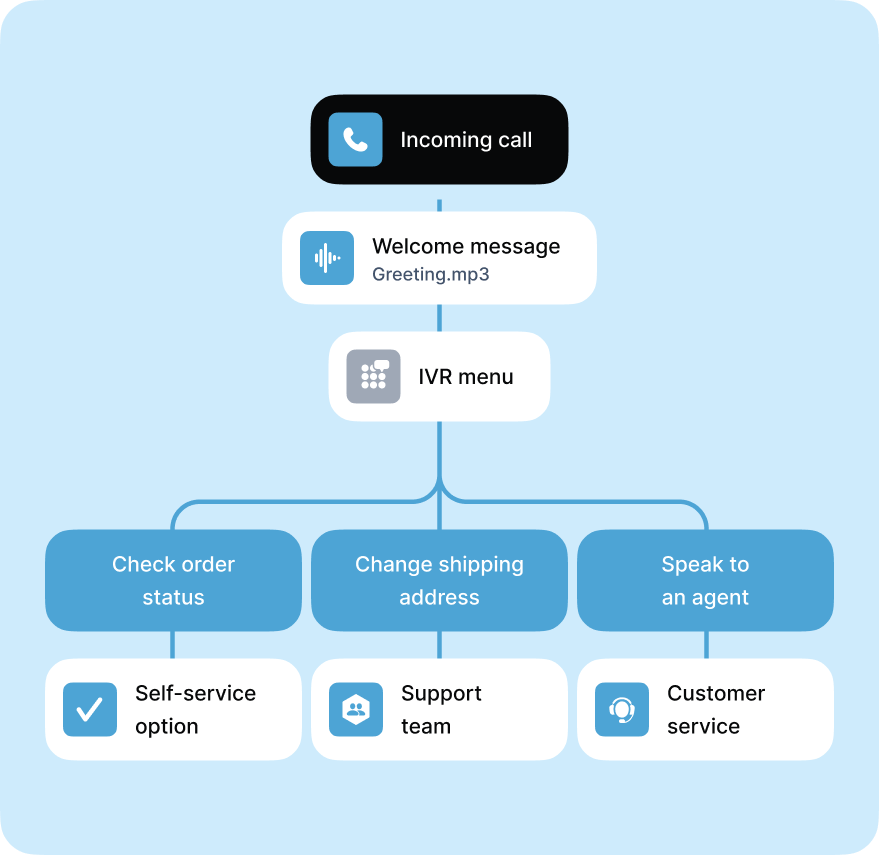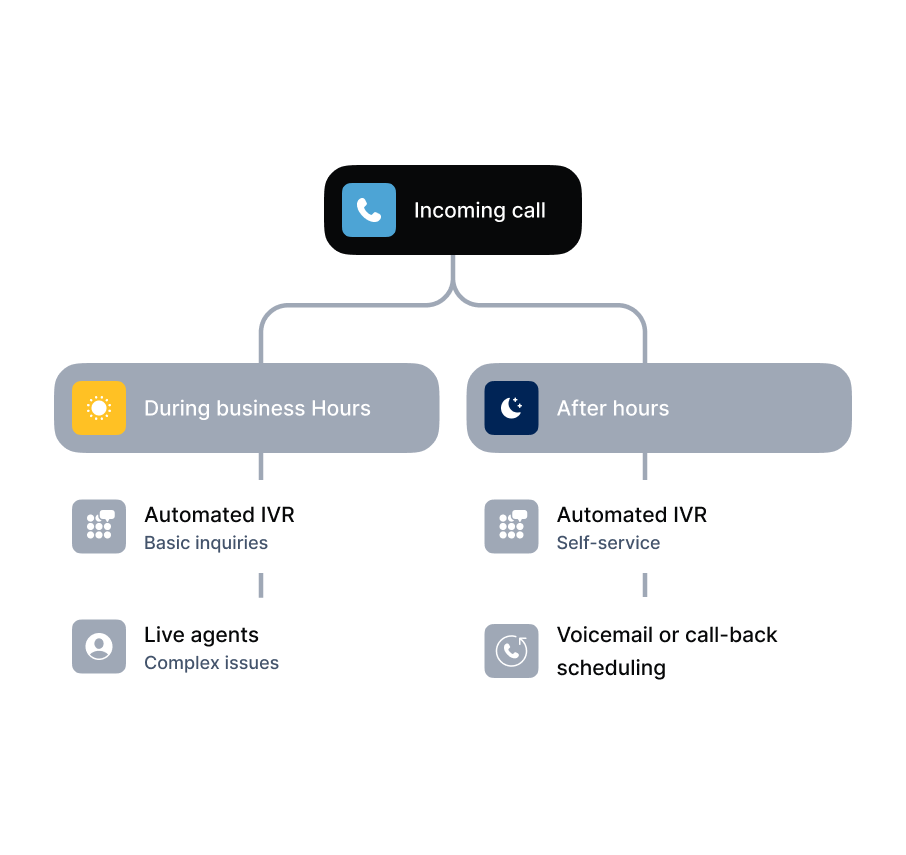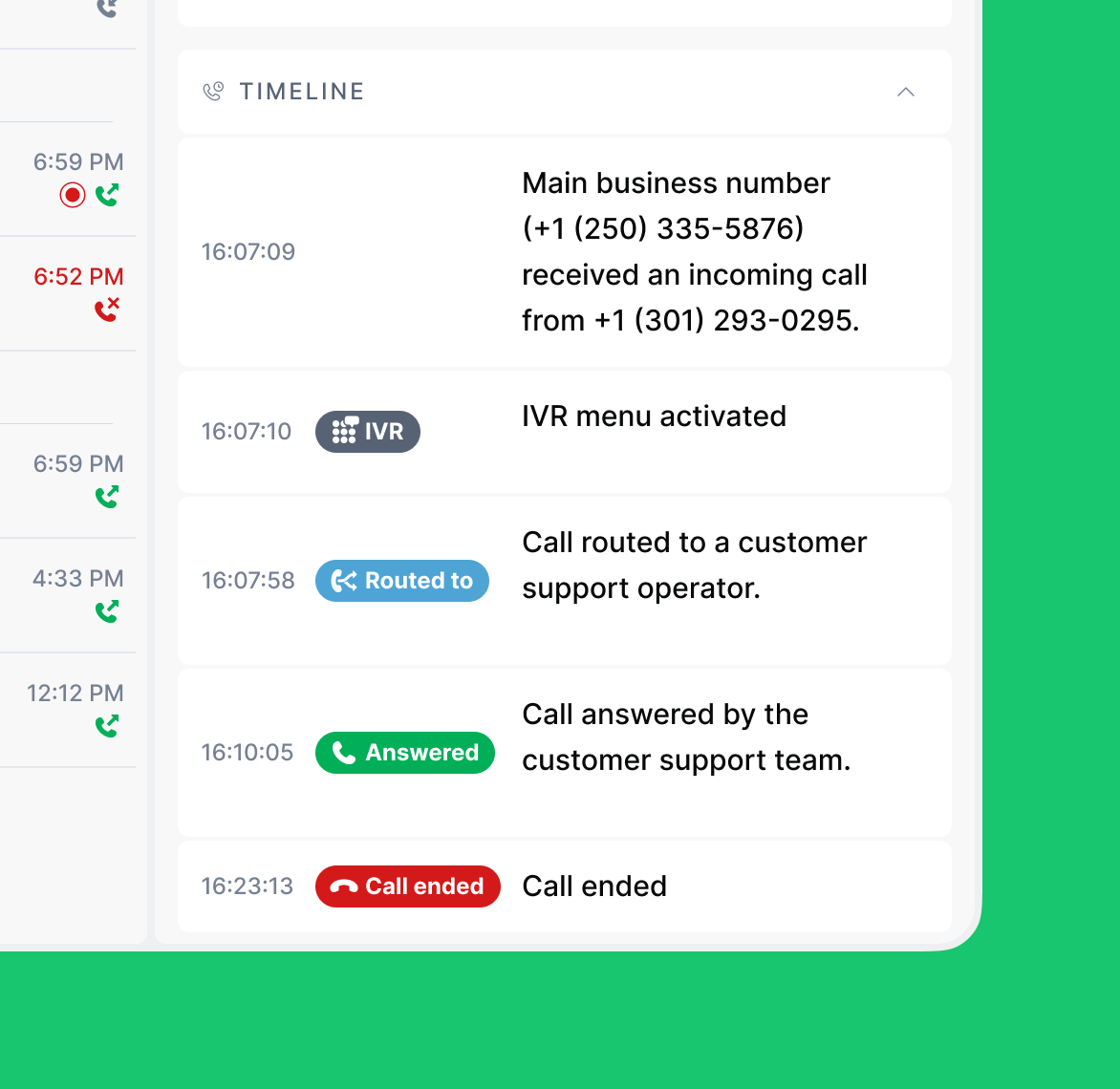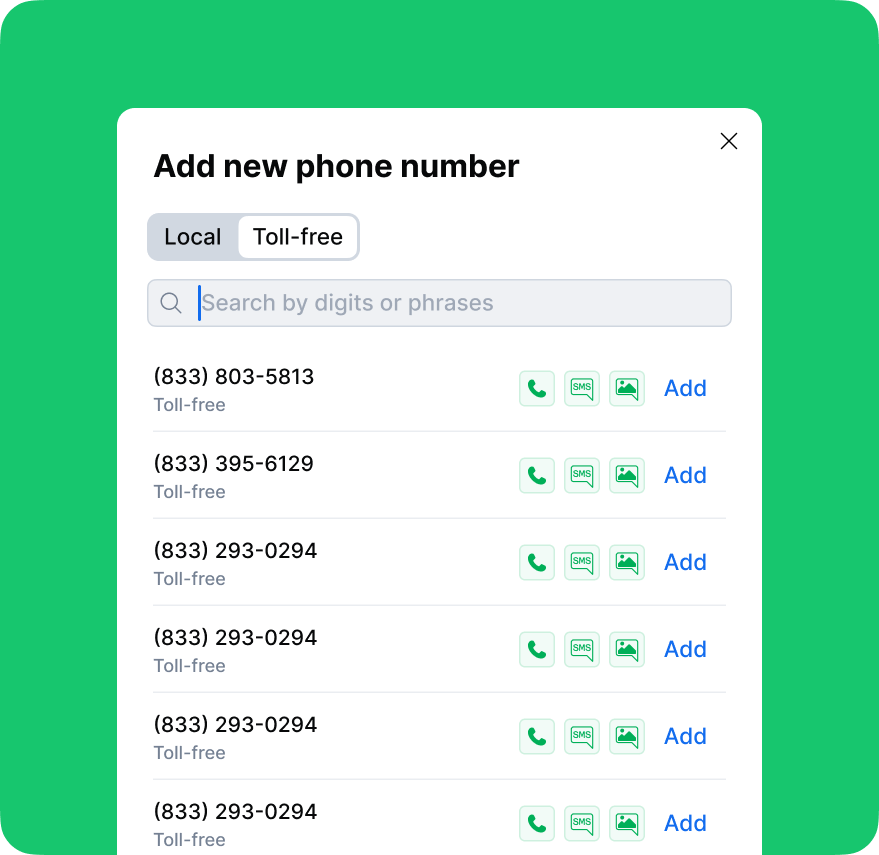Blog
Cloud Phone System
What Is Interactive Voice Response (IVR)?

What Is Interactive Voice Response (IVR)?
Learn what IVR systems are, how they work, and best practices for creating a customer-friendly IVR menu.
Most of us have experienced IVR systems at some point: think of the familiar voice that says, “Press 1 for billing, press 2 for support, press 3 for an operator” when you call an insurance company or bank. For decades, IVR has been a cornerstone of business phone communication, helping organizations route calls efficiently and reduce customers’ wait times.
But as the very first touchpoint between your business and a customer, your IVR menu can make or break the caller’s experience. A well-configured IVR guides callers quickly to the right place, while a poorly designed one can feel like a frustrating maze of endless sub-menus.
In this article, we’ll break down what IVR is, how it works behind the scenes, best practices for building a customer-friendly IVR menu, and whether IVR still makes sense for modern businesses.
What is IVR?
IVR, or Interactive Voice Response, is a phone system technology that allows businesses to greet callers, interact with them through pre-set menu options, and route calls to the right department or even provide self-service without speaking to a live agent.
The concept of IVR dates back to the 1960s, when early experiments in automated call handling began. At the time, the technology was expensive and limited, but it set the stage for what would later become a mainstream tool. By the 1990s, IVR systems surged in popularity. One of the key drivers was the sharp drop in the cost of hard drive storage, which made it affordable for businesses to use.
During this era, IVR systems were more than just call routing solutions. With the internet still in its infancy, many people relied on IVR menus to get information directly from businesses. Customers would call airlines to check flight schedules, banks to hear account balances, or retailers to find store hours.
Over the years, IVR technology has evolved dramatically, from basic touch-tone systems that required pressing keypad numbers, to more advanced platforms that incorporate speech recognition and even AI-powered natural language processing.
Let’s take a closer look at the different types of IVR systems that have existed and continue to shape the way businesses handle customer calls.
Types of IVR Systems
As technology advanced, IVR systems evolved to offer customers more natural and convenient ways to interact with businesses. Over time, these systems have moved from rigid menu-based navigation to more flexible, conversational experiences. Here are the main types of IVR:
Touch-Tone IVR (DTMF-Based)
This is the most basic and widely recognized form of IVR. Customers interact by listening to prompts such as “Press 1 for billing, press 2 for technical support” and selecting options using their phone keypad. Each key press generates a Dual-Tone Multi-Frequency (DTMF) signal, which the IVR system interprets to route the call or provide information. While simple and reliable, touch-tone systems often force callers through long menu trees, which can feel cumbersome.
Directed Dialog IVR
A step up from touch-tone, directed dialog IVR uses voice prompts to guide callers through specific, predefined options. For example, the system might say: “Please say ‘account balance’ or ‘make a payment’.” This approach reduced the need for keypad input and was considered more natural at the time. However, it required callers to repeat very specific words or phrases. If the system couldn’t recognize the response, customers often got stuck or had to restart, leading to frustration.
How Does an IVR System Work?
IVR systems can operate over both public switched telephone networks (PSTN) and modern voice over IP (VoIP) networks, making them adaptable to different business phone infrastructures. Regardless of the underlying network, the core logic of how IVR works is similar: it acts as a middle layer between the caller and the business, guiding the interaction and routing the call appropriately.
The logic of how an IVR system works is as follows:
Caller Interaction and Menu Navigation
When a caller dials a company’s number, an auto-receptionist automatically answers and greets them with a pre-recorded or dynamically generated message. From there, the IVR solution starts presenting menu options: these can be as simple as a single-level menu (“Press 1 for sales, Press 2 for support”) or more complex multi-level menus that branch into several sub-options.
Depending on the type of IVR deployed, the caller interacts with the menu in different ways:
- Keypad input (DTMF): The caller presses numbers on their phone keypad. Each key press generates a Dual-Tone Multi-Frequency (DTMF) signal, which the IVR system interprets to route the call.
- Voice commands: In more advanced systems, callers respond verbally, and the IVR uses speech recognition to detect the spoken option.
Call Routing
Once the caller selects an option, the IVR system applies the routing logic configured by the business. This can include:
- Directing the call to a department or team (e.g., billing, technical support, sales).
- Sending the caller to a specific individual or extension.
- Placing the caller in a call queue until an agent becomes available.
- Offering self-service options such as checking account balances, making payments, or hearing store hours without speaking to a live agent.

Business Logic and Flexibility
The flexibility and sophistication of IVR call flows depend largely on the capabilities of the solution provider. Basic systems may only support static routing, where calls always follow a fixed path regardless of the caller. By contrast, advanced IVR platforms enable businesses to design dynamic, rules-based logic that adapts to each customer’s specific situation.
Modern IVR systems can integrate with internal databases and CRMs, making interactions far more personalized. For example, the system can prompt a caller to enter an account number or customer ID, verify their identity with a PIN or other security credentials, and then instantly retrieve relevant data, such as account balances, order status, or recent transactions.
Benefits of Using IVR for Businesses
IVR systems have long been a core technology for organizations of all sizes, from small businesses to large enterprises, because they provide an efficient and cost-effective way to automate and organize incoming calls. Even a simple IVR menu can distribute caller traffic more effectively than a human receptionist, offering clear advantages to both businesses and customers.
Simplified Call Management
One of the biggest benefits for businesses is efficient call management. With IVR, no matter how high the call volume gets, the system can accept and organize calls according to predefined routing rules. Callers are directed to the right department, individual, or placed in a call queue if needed.
This structure also offers flexibility and scalability. As your business grows, call volumes increase, or departments evolve, the IVR system can be updated to reflect new needs without requiring significant additional resources.
Improved Customer Experience
For customers, IVR means faster access to help. Instead of hunting for the right phone number, they can dial a single main business line and be routed automatically to the appropriate team. This reduces wait times and minimizes frustration.
Advancements in speech recognition and natural language processing have made IVR menus even more user-friendly. Customers can now interact with the system conversationally, rather than pressing endless keypad options, making the experience more seamless and natural.
Reduced Operational Costs
Compared to employing a team of receptionists to route calls, IVR systems are significantly more cost-efficient. They eliminate the need for dedicated staff to distribute calls and reduce the expense of staffing late-night shifts.
Additionally, self-service options allow customers to resolve common issues such as checking an order status or paying a bill, without ever reaching an agent. This frees up human staff to focus on more complex interactions.
Cost-Effective 24/7 Availability
Unlike human receptionists, IVR systems are available around the clock. Customers can call anytime, even outside of business hours, and still receive assistance. After-hours messages can direct them to self-service options or, if necessary, connect them to staff working late night shifts. This ensures that customer support remains accessible without the overhead of staffing a 24/7 reception team.

Challenges of Using IVR
Like many technologies, IVR comes with both strong advantages and manageable disadvantages. While it can streamline call handling and reduce costs, businesses should be aware of common challenges in order to design systems that minimize frustration and maximize customer satisfaction.
Overloaded IVR Menu Options
One of the most frequent complaints about IVR systems is menu overload. Long lists of initial options or multiple layers of sub-menus can feel like an endless maze. In addition, lengthy pre-recorded greetings prevent callers from reaching their desired option, often leading to frustration, abandoned calls, or negative customer experiences.
How to mitigate: Keep menus simple, concise, and limited to a few core options. Break down information into smaller segments and prioritize the most common requests. Always give callers a quick way to connect with a live agent if they cannot find the right option.
Impersonal Interactions
Automated systems with monotone or robotic-sounding greetings can feel cold and impersonal, especially when callers are dealing with urgent or emotional issues. This lack of a “human touch” may negatively impact brand perception.
How to mitigate: Use modern speech technology to create friendlier, more natural voice recordings. Most importantly, provide a clear path to escalate to a live agent when the situation requires empathy or human judgment.
Long Wait Times from Poor Call Routing
Although IVR is designed to reduce wait times, it can sometimes contribute to them. Callers may be placed in long queues after navigating menus or get stuck in loops if the system doesn’t recognize their input. This can lead to frustration and abandoned calls.
How to mitigate: Regularly analyze your call history to identify bottlenecks and adjust your IVR routing logic accordingly. Streamline menu paths, reduce unnecessary steps, and ensure prompts are clear. Instead of forcing customers to remain on hold, offer a call-back option so they can be contacted as soon as an agent becomes available.

Industry Use Cases of IVR
The main users of IVR systems are call and contact centers, where the technology helps manage high volumes of daily inquiries. Its primary role is to distribute calls efficiently, routing customers to the right department or agent who can best assist with their request. This reduces unnecessary transfers, shortens wait times, and ensures a smoother experience. In addition, many IVR systems also provide self-service options for routine needs, helping to further ease the workload on human agents.
Let’s look at some common use cases across industries:
Banking and Finance
Banks use IVR software to connect callers with department for loans, credit cards, or account services. Customers with everyday needs, such as checking a balance or confirming a transaction, can often resolve them through self-service options.
Retail and E-Commerce
Retailers rely on IVR to direct callers to order support, returns, or store assistance teams. Self-service options often include package tracking or store hours, saving agents for more complex issues.
Healthcare and Medicare
Hospitals and clinics use IVR to route patients to scheduling, billing, or records offices. Routine actions like confirming appointments or requesting prescription refills can often be handled automatically.
Travel and Hospitality
Airlines and hotels distribute calls through IVR to reservations, loyalty programs, or customer service desks. Automated options may provide quick access to flight status, booking confirmations, or check-in information.
Telecommunications
Telecom providers depend heavily on IVR to guide customers to billing, technical support, or account management departments. Common requests such as checking data usage or making payments can often be completed without live support.
Logistics and Shipping
Logistics companies use IVR to route callers to delivery support, claims, or scheduling teams. Customers can also check shipment status and tracking details via automated self-service.
Professional Services
Law firms, consultancies, and other service providers leverage IVR to distribute calls among different offices or practice areas. Recorded menus can also provide routine details such as office hours and locations.
Government Agencies
Government offices employ IVR to direct callers to the correct department or service line, whether for taxes, licensing, or benefits. Citizens may also use self-service menus to check payment statuses or renewal requirements.
Best Practices for Implementing IVR
A well-designed IVR menu can truly help your business streamline incoming call flows and please customers with excellent service. Poorly designed systems, however, can frustrate callers and damage customer trust. To get the most out of your IVR, keep these best practices in mind:
Provide a single, easy-to-find contact number: Whether it’s a toll-free number or a local number forwarded to your main line, make sure customers have one consistent and recognizable number to call. This removes confusion and ensures they know exactly how to reach your business every time.

Keep menus simple and clear: Don’t overload callers with endless choices. Use a short greeting and limit the main menu to 4–5 options at most. A concise menu is easier to remember, reduces caller fatigue, and makes it quicker for customers to navigate to the right destination.
Avoid long initial messages: Lengthy introductions that talk about your entire business only delay callers from getting help. Instead, keep greetings short and move quickly to menu options. If callers are on hold or being transferred, avoid repetitive filler messages like “Your call is important to us.” Instead, provide genuinely helpful updates, light background music, or, even better, offer a call-back option so they don’t have to wait on the line.
Always provide a human option: Your IVR should never feel like a dead end. Always include a simple way to reach a live agent. Some issues require human help, and some customers simply prefer speaking with a person. Giving them an “escape route” prevents frustration and dropped calls.
Support multiple languages: If your business serves a multilingual audience, offering callers the option to interact in their preferred language improves accessibility and customer satisfaction. For example, starting with “Press 1 for English, Press 2 for Spanish” ensures inclusivity.
Personalize where possible: While personalization isn’t always possible at the start of a call, modern IVR systems that integrate with CRMs and databases can tailor the experience once a caller is identified. Customers can be greeted by name and offered relevant options based on their history.
Test, monitor, and update regularly: Customer expectations and business needs evolve over time. Regularly analyze call logs, monitor abandonment rates, and collect customer feedback to identify bottlenecks. Update your IVR menus periodically to reflect new products, departments, or customer preferences.
DialLink AI Voice Agents: From Phone Menus to Human-Like Dialogue
No matter how much IVR systems have advanced, the core experience hasn’t changed — callers are still forced to navigate through phone menus. For many customers, this feels outdated, frustrating, and inefficient like technology stuck in the 1990s. A poorly designed IVR doesn’t just annoy callers but even costs businesses money.
By contrast, AI voice agents bring a modern, human-like experience to customer interactions. Instead of pressing buttons or repeating scripted phrases, callers can simply explain their needs in their own words. The AI understands intent, responds intelligently, and guides them smoothly toward resolution.
Here’s how AI voice agents go beyond IVR:
- Natural, conversational experience: Callers engage in free-form conversation without memorizing menu options. The interaction feels more like speaking to a real assistant than navigating a machine.
- Smarter intent recognition: Powered by advanced speech processing, AI can interpret requests accurately, even when callers use unexpected wording or provide extra context.
- Built-in expertise: Trained on your knowledge base of FAQs and guides, AI receptionists can deliver instant, reliable answers, resolving many common issues without sending callers deeper into a menu tree.
- Automated task handling: With MCP (Model Context Protocol) integrations, AI receptionists can take real action such as looking up customer records, scheduling appointments, or updating CRM systems. Traditional IVR can’t match this level of functionality.
- Contextual warm transfers: For issues requiring live support, AI voice agents can intelligently route calls to the right call queue, ring group, or specific user, ensuring a smoother handoff than traditional IVR.
While AI voice agents may involve a higher initial investment than traditional IVR, they provide greater automation and personalization, making them the clear next step for businesses ready to modernize their call management.
Conclusion
IVR is not a new technology; it’s been around for decades and became popular as a way to manage high volumes of incoming calls without requiring a live receptionist on every line. By guiding callers through menu options, IVR has helped businesses lower staffing costs and maintain structured, efficient call routing. Yet the core experience has barely changed, and for many callers it now feels outdated and frustrating.
With DialLink’s business phone system, even small businesses and startups can build single and multi-level IVR menus quickly using intuitive settings. They also can go beyond robotic interactions with built-in AI voice agents. This brings together the best of both worlds: the efficiency of IVR for organizing calls and the intelligence of AI to hold natural conversations, automate routine tasks, and deliver a modern, customer-friendly calling experience.
IVR stands for Interactive Voice Response. It’s a phone system technology that allows callers to interact with automated menus using their keypad or voice commands, which then routes them to the right department or provides self-service options.
IVR isn’t just for large companies. Many small businesses use it to appear more professional, manage calls without hiring extra staff, and ensure customers always reach the right person or department. Cloud-based solutions like DialLink make IVR solutions affordable even for small businesses and startups.
Most modern IVR solutions are highly customizable. Businesses can set up unique greetings, design call flows for different departments based on business hours, offer multiple language options, and integrate the IVR with CRMs or databases for personalized interactions.
Yes. Unlike a human receptionist, IVR systems can handle calls around the clock. After business hours, they can route callers to voicemail, provide self-service options, or even forward urgent calls to on-call staff.
Yes. Even though many customers now rely on websites, mobile apps, and chatbots for quick self-service, phone support remains a critical channel, especially for complex issues. IVR systems continue to play an essential role in managing and streamlining that phone support.
Share this post

Arina Khoziainova
Content Writer at DialLink
Arina is a content writer with over 7 years of experience in the IT industry. At DialLink, she creates clear, insightful content that helps small business and startup owners simplify communication and drive growth using modern tools. With a strong focus on practical value, Arina transforms complex topics into accessible, actionable stories.
Keep Reading

Auto Attendant Recordings: Examples, Samples and Best Practices for Small Businesses
Explore auto attendant recording examples, samples, and tips for small businesses and startups to create professional phone greetings.
December 24, 2025
7 minutes

AI Phone System Explained: A Complete Guide for Businesses
Learn what an AI phone system is, how it works, and explore its key features, common use cases, and real-world applications across industries.
October 16, 2025
14 minutes

What Is a Virtual Call Center and How to Start One for Small Businesses?
Discover what virtual call centers are, their key benefits and challenges, and get guidance on how small businesses can launch one successfully.
August 12, 2025
17 minutes

Google Voice Auto Attendant: What It Is and How It Works
Explore how Google Voice auto attendant works and whether it’s right for your small business.
December 22, 2025
9 minutes